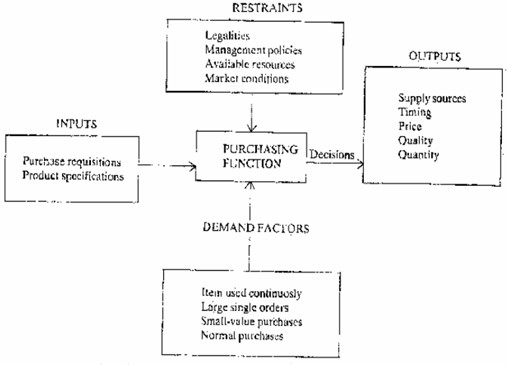From our daily life we know that every one of us depends on commodities and services supplied by other individuals or organizations. Similarly, every organization, big or small, to varying extents, depends on materials and services from other organizations. These materials and services are obtained through exchange of money. This process of exchange is known as purchasing. In the present context, we shall concentrate on the purchase of materials. Materials constitute an important, ingredient of inputs to the activities of several types of organizations. Industries require raw materials, components and equipments for their production, service organizations require supplies, spare parts are required for maintenance operations, and so on.
Furthermore, in most of the organizations, the value of materials as compared to other inputs to the system is high. In an industry, on an average about 40 to 60 per cent of the total money is spent on materials and related services. Similar estimates about the large sums of money involved can be made for public works departments, electricity Boards, developmental agencies, corporations etc.
With the increasing complexities in materials’ characteristics and their usage vis-a-vis increasing competition, the purchasing function has emerged as a specialized organizational activity. In many organizations, it is regarded as supportive functions. However, in order to attain the maximum contribution to the efficiency and effectiveness of an organization, the purchasing should be treated as one of the functional areas.
Objectives
Purchasing principles are usually epitomized as buying materials of right quality, in the right quantity, at the right time, at the right price, from a right source and also at the right place. The main objectives are:
- To make the user departments of the organization from time to time aware of the range of the quality of materials available in the market and to maintain the right quality of purchased materials based on standards, technical specifications and suitability as determined by the user departments.
- To procure at the lowest possible cost consistent with quality and service requirements.
- To ensure the minimum possible investment in service operations related to purchased materials,
- Such as transportation, inspection, storing, record keeping etc.
- To maintain continuity of the supply to ensure that scheduled activities are not interrupted.
- To integrate the requirements of all departments of the organization in order to take the advantage of economy of scale wherever possible and to also avoid duplications of purchases resulting in wastes and obsolescence
- To create goodwill for the organization through healthy buyer-supplier relationship
Purchasing Functions
In order to meet the above objectives of the purchasing functions, the requisite inputs and possible restraints and factors must be identified. The purchasing function is responsible for a host of decisions. Figure I depicts the purchasing function.
In addition to the outputs shown in Figure I, responsibilities of the purchasing department include other related activities:
(1) Vendor Rating and Development, (2) Make or Buy, (3) Value Analysis,
(4) Surplus Disposal, (5) Control and Audit, Maintenance and Development of Procedures, Forms, Records and Reports.
We shall discuss the relevant points with reference to Figure I in subsequent sections.


